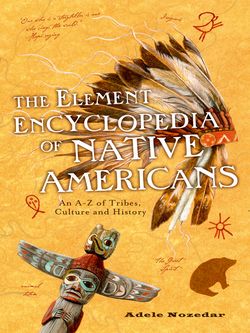Читать книгу The Element Encyclopedia of Native Americans: An A to Z of Tribes, Culture, and History - Adele Nozedar - Страница 16
ALEUT
ОглавлениеOriginally from the Aleutian Islands, which extend in a westerly direction from Alaska for a distance of about 1,200 miles to the Pacific Ocean, the name Aleut is believed to mean either “Island” or, alternatively, “Bald Rock,” from a Russian word. “Alaska” is from an Aleutian phrase meaning “mainland.”
Aleut culture was very similar to that of the Inuit. Both peoples belong to what is termed the Arctic Culture Area. Their livelihood was based almost entirely on the ocean: they hunted sea mammals, such as otters and whales, and fished, using the traditional baidarkas—a kayak-like vessel made from waterproofed oiled sealskins stretched over a wooden frame. Much of the hunting for larger sea mammals was carried out using a harpoon. The Aleut seafood diet was supplemented with seasonal berries, fruits, and roots. Aleuts lived in partially buried homes called barabaras—large buildings shared by a number of families. Beautiful, intricately decorated baskets were made from the rye grass growing along the edges of the beaches. Shells and amber were used as currency.
In such a harsh climate, the Aleuts had to be particularly ingenious about keeping warm. Their clothing was generally double-layered to preserve heat, made from animal hides and also animal guts. It is the Aleuts that we have to thank for the parka—the long, hooded coat that is worn all over the world.
The coming of the Europeans and their involvement in the fur trade had a significant impact on the traditional Aleut way of life. The first explorer, Vitus Bering of Denmark, working under the auspices of the Russian Czar Peter the Great, arrived on the Aleutian Islands in 1741. His reports of the rich sealife and opportunities for fur trading soon saw a large contingent of prospectors from Siberia arriving in the area. Their methods of working were harsh for the Aleuts. Arriving in a village, hostages were captured, primarily women and children. The men were then forced to trade furs in return for the safe return of their families. The women and children were used as slaves, forced to skin the animals and clean the furs. The Aleuts rebelled in 1761 and succeeded in killing a group of traders; however, the Russians responded by sending in a veritable armada of warships, and blasted many Aleut villages to smithereens with their cannons.
Thereafter, the Russians made some attempts to regulate the fur trade and to treat the Aleuts and the Inuit more fairly, including actually paying them for their efforts. This just meant that the traders found new ways to cheat the Aleut, inventing charges such as fees for food and transportation. The end of the 18th century saw the founding of the Russian American Company, a massive fur-trading company which would become the main competitor with the British Hudson Bay Company.
